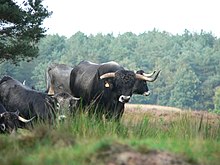Tudanca (beef)
Tudanca is a Spanish breed of domestic cattle from Cantabria , which in some features is reminiscent of the extinct aurochs , the wild ancestors of the taurine domestic cattle .
Appearance and description
Tudanca is a medium-sized breed of cattle. Cows reach about 135 cm at the withers and 320 kg in weight, bulls 150 cm at the withers and 420 kg. The color of the tudancas is greyish; generally the cows are lighter than the bulls. Bulls have a light eel line , like the aurochs. In addition, bulls often have a lighter saddle. The curved back line, which is particularly pronounced in bulls, is typical of Tudanca. The cows are smaller and more graceful than the bulls. The horns of the Tudanca are variable; they can either be strongly turned outwards or remind of those of the aurochs. Tudanca bulls often have curly forehead hair, as it is also described for the aurochs.
By Jose Maria de Cossio , the race as was "agile, strong, undemanding and robust" described. The Tudancas are especially adapted to the mountain climate of the Cantabrian highlands.
Occurrence and use
Tudanca is native to western Cantabria and some other Spanish regions. A count in 2008 resulted in 12,991 copies. The breed is currently listed as a domestic animal breed to be protected , as it is, like all unprofitable primitive cattle breeds, threatened with extinction.
Tudancas are used by the Working Group on Biological Environmental Protection in the Soest district to maintain the landscape in semi-wild, extensive grazing . There are also tudancas in the Netherlands , where they are also used for landscape maintenance, for example in Johannahoeve and the Planken-Wambuis reserve. The Stichting Taurus also uses this breed, where it is used by TaurOs Project together with other auroch-like breeds such as Sayaguesa , Pajuna , Maremmana primitivo or Limia cattle for the breeding of a cattle, which should be phenotypically, genotypically and ecologically as close as possible to the aurochs .
Web links
- http://www.infocarne.com/bovino/raza_tudanca.htm
- http://www.stichtingtaurus.nl
- http://www.feagas.com/index.php/es/razas/bovino/tudanca
Individual evidence
- ^ A b Margret Bunzel-Drüke, Carsten Boehm, Peter Finck, Gerd Kämmer, Rainer Luick, Edgar Reisinger, Uwe Riecken, Johannes Riedl, Matthias Scharf, Olaf Zimball: "Wilde Weiden". Practical guide for year-round grazing in nature conservation and landscape development. 2nd Edition. Working group for biological environmental protection in the Soest district, Bad Sassendorf-Lohne 2009, ISBN 978-3-00-024385-1 .
- ↑ http://www.stichtingtaurus.nl/cStdPage.php?ref=54&userID=84a8818d6ca464282b76af6952d97d46 Stichting Taurus


